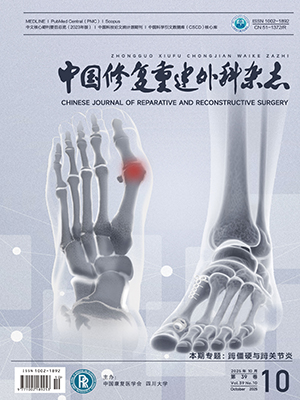Objective To explore the effectiveness of proximal femoral nail antirotation (PFNA) combined with minimally invasive clamp reduction technique by Kocher pincers in the treatment of irreducible intertrochanteric femoral fracture in the elderly. Methods The clinical data of 35 elderly patients with irreducible intertrochanteric femoral fractures who were treated with PFNA combined with minimally invasive clamp reduction technique by Kocher pincers between January 2016 and December 2022 were retrospectively analysed. There were 16 males and 19 females, aged from 63 to 95 years (mean, 75.2 years). The causes of injury included traffic accident in 3 cases and falling in 32 cases. The time from injury to operation was 2-11 days (mean, 3.6 days). According to AO/Orthopaedic Trauma Association (AO/OTA) classification system for intertrochanteric fractures, there were 14 cases of type A1, 18 cases of type A2, and 3 cases of type A3. According to the displacement of fracture by intraoperative fluoroscopy, there were 5 cases with only coronal displacement, 17 cases with only sagittal displacement, and 13 cases with both coronal and sagittal displacement. The operation time, intraoperative blood loss, rate of hemoglobin decline at 1 day after operation, length of hospital stay, and fracture healing time were recorded. The reduction quality of fracture during operation was evaluated according to reduction quality criteria proposed by Chang et al. The Harris scoring system was used to evaluate the hip joint function at last follow-up. Results The operation time was 45-105 minutes (mean, 54.4 minutes); the intraoperative blood loss was 80-300 mL (mean, 116.3 mL). The reduction quality of fracture during operation was good in 22 cases (62.9%) and acceptable in 13 cases (37.1%). The rate of hemoglobin decline at 1 day after operation ranged from 6.2% to 18.6% (mean, 10.2%); the length of hospital stay was 5-18 days (mean, 7.2 days). One case died of respiratory failure due to pulmonary infection, 2 cases were lost to follow-up, and the remaining 32 cases were followed up 6-24 months (mean, 10.6 months). All 32 patients achieved bony union and the healing time was 3-9 months (mean, 3.6 months). There was no complication such as incision infection, internal fixation failure, or coxa varus during follow-up. At last follow-up, the Harris score of hip joint was 67-96 (mean, 88.9); among them, 19 cases were excellent, 10 cases were good, 2 cases were fair, and 1 case was poor, with an excellent and good rate of 90.6%. Conclusion For the elderly patients with irreducible intertrochanteric femoral fracture, the application of PFNA combined with minimally invasive clamp reduction technique by Kocher pincers can achieve high-quality fracture reduction, which has the advantages of simple reduction operation, less trauma, and can avoid the radiation exposure of operators during maintenance reduction.
Citation:
TANG Hongwei, YIN Yong, MA Yinhua. Treatment of irreducible intertrochanteric femoral fracture in elderly with proximal femoral nail antirotation combined with minimally invasive clamp reduction technique by Kocher pincers. Chinese Journal of Reparative and Reconstructive Surgery, 2025, 39(5): 536-541. doi: 10.7507/1002-1892.202503024
Copy
Copyright © the editorial department of Chinese Journal of Reparative and Reconstructive Surgery of West China Medical Publisher. All rights reserved




